Content
- Qualitative and Quantitative appraoches (physical, tactical, technical and behavioual)
- Intrepetation of data
Performance Analysis involves the ability to identify playing/performing strengths and areas where improvements are required by both individuals and teams. It is a source of feedback to the coach, teacher and ultimately the performer.
Performance analysis plays a key role within the coaching process and informs all aspects of the model.
The Coaching Process
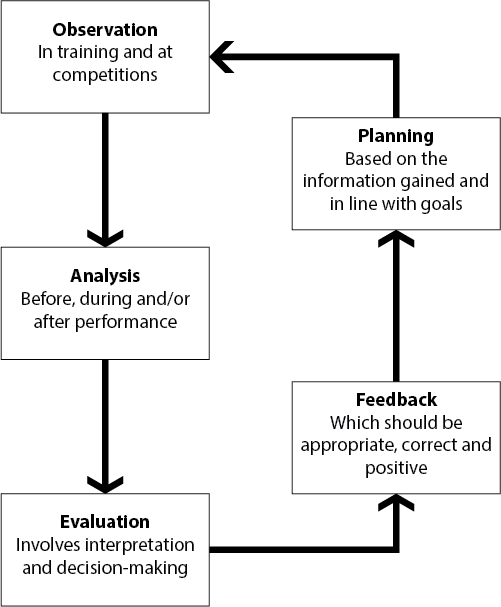
This area deals with the monitoring and evaluation of human performance. This is mainly carried out through fitness testing; within modern elite sport the margins of winning and losing are extremely fine with physical preparation a key element in success. Fitness testing provides coaches with an overall fitness profile of the sportsperson. These profiles will be specific to that sport or even the position they play e.g. A prop in rugby will have a different fitness profile to that of a winger due the differing demands of the position. Modern forms of testing are getting more complex and detailed using highly specialised monitoring and recording equipment. Such specialised tests are deemed Laboratory Tests (hyperlink to video of tests). The coach and the performer to can use this information to: -
Inevitably there are drawbacks with such equipment, mainly centred around cost and the specialist nature of the testers and equipment, this means that only the top elite sportspeople access such continual testing.
Essentially, performance analysis is about creating a reliable record of performance by means of observations that can be analysed, with training programmes and team selection adapted based on these observations.
Tactical and Technical Performance analysis can be broken down into two separate but related disciplines:
The two disciplines use similar methods to collect data, and both rely on IT for the analysis of data.
In both individual and team sports, it is difficult, if not impossible, for coaches to notice and remember all the key events occurring within a training session or match, equipped only with their knowledge of sport and their powers of observation. Human observation and memory are not reliable enough to provide the detailed information necessary for performance development. A study by Franks and miller (1986) showed that football coaches were less than 45% accurate in their post game assessment of what occurred during a game. Factors that affect a coach’s perception include: -
As a result Notational Analysis systems have been formed to provide far greater objectivity (definite statistics etc.) rather than the coaches subjective analysis. Notational analysis has developed rapidly over the last decade and has been facilitated by advances in IT resources available to coaches. It can take the form of real time hand or computer notation (takes place during the event) or video/computer analysis (post event). Notational analysis is now acknowledged as an aid to performance enhancement at all levels.
Performance can be analysed in a variety of ways using notational analysis:
Notational analysis is a process whereby a game is analysed (either live, or after the game) based on a number of performance indicators that have been established.
Live notational analysis previously took place using paper and pen methods, but with the inception of recent technology and specialist performance analysists, computer software is commonly used with high level sport.
A template is devised and performance is noted for each player based on the template. The coach manually records all of the events in the game, presenting summaries to other coaches and players where necessary during the game.
Advantages of real time analysis
Disadvantages of real time analysis
Post match notational analysis involves the use of specialised computer software with a recording of the match with the coach or performance analyst noting a number of outcome. After viewing and ‘coding’ matches performance analysts produce video/computer compilations of aspects of play for later use. Furthermore, statistical data is also gained from the matches. Prior to the advancement of computer software coaches used a video or DVD of each game and would provide feedback on the basis of this. With the advent of modern computer software, both players as well as coaches will also review their own and the teams performance. It is a very useful method for players to be responsible for taking ownership of developing their own sporting performance.
Software is used that allows live analysis of games, where the match is recorded directly onto a laptop allowing the coach to record all of the match events and create a video compilation instantly. Such information is often fedback to players at half time or during breaks in –play.
GPS systems are now commonplace within elite sport, these systems are used to aquire information about the players in either match or training situations. Modern GPS systems measure distance covered, speed over set distances, heart rate and even the force of any collision or impact. Such information can be used to inform specific strength and conditioning programmes and can be used to formulate changes in tactics, training session length and intensity or even team selection.
Advantages to Post Match Video/Computer Analysis
Disadvantages to Post Match Video/Computer Analysis
| Pre-game | During-game | Short-term post-game | Long-term post-game |
|---|---|---|---|
| Education | Half time feedback | Team de-brief | Player audits |
| Tactical | Full time feedback | Unit de-brief | Team audits |
| Movtivation | Player de-briefs | Research | |
| Opposition | Trends |
The first step in notational analysis is to outline the possible events in a game and prioritise which to include in the analysis. This means defining the range of possible actions in the game and linking these actions with possible outcomes – for example a goalkeeper’s kick, throw out etc, would constitute an action, whereas maintained possession from defence, midfield, attack are outcomes. In most games there are an almost infinite number of possible actions and outcomes ensuring that the coach must prioritise those, which influence the game most. E.g. In Rugby, defence/denying a gain line from 1st phase situations. Netball, centre pass success rate. Similarly a coach can receive data on either individual players or the team as a whole. Here is an example of the process a football manager may go through when deciding on what he wants analysed: - (see next page)
The Coaching Process
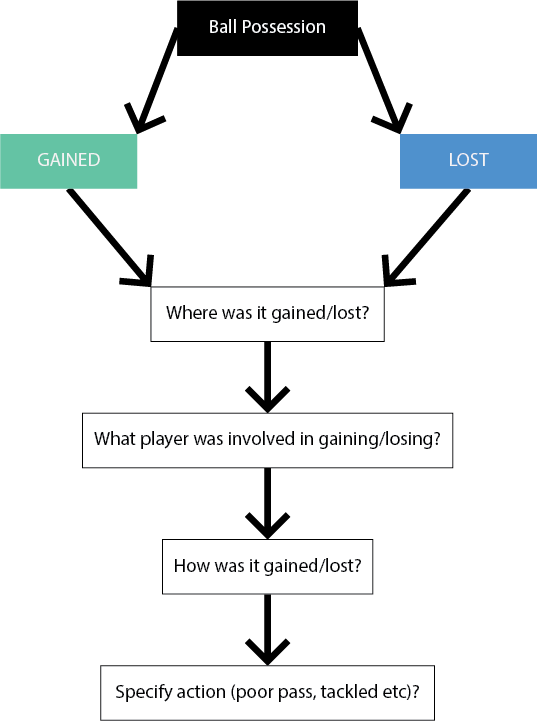
Using these events and outcomes, it is possible to create a paper template – or an electronic template if using a software package – that the coach uses to analyse the game. Each time an action occurs in the game, the analyst notes the action and the outcome e.g. Action = Pass over 5m Outcome = Accurate. By analysing all of the outcomes it may be possible to pinpoint areas that require adjustment within the team. This type of analysis enables the coach to create an objective statistical analysis of the match to use when giving feedback, whether that is during the game or in subsequent coaching sessions or team meetings.
It is important to be careful with how the data is presented since, in isolation, these can give a distorted impression of performance.
Comparing performances between teams, team members and within individuals is often easier and more accurate if the performance indicators are expressed in terms of percentage success to failure, such as possession to turnovers, winners to errors, and passes received to passes completed. For example netball Goal Shooter may have scored 50 of the 70 goals during a match, which seems very good. However if the Goal Shooter had 100 attempts on goal her shooting ratio is 50%. While the Goal Attack may have only scored 20 goals but only had 30 attempts, this gives and average of 66% which is a better average. This highlights the importance of having the full statistical data. It would then be up to the coaches as to how this data is used, is it better to have more shots and more misses or fewer shots with a high success rate?
Video footage is usually presented via television, although presentations on a computer enable much more flexibility when presenting information to players. Computer software can be used to enhance the visual information that players are shown, by highlighting key situations in the game and using these for feedback purposes. Often the video itself will be broken down into sections for ease of viewing. E.g. attack and defence, these would then be further subdivided into more segments and so the process would continue until the coach is happy the video footage highlights key points. Statistics from notation analyses can be presented to players or other coaches visually via charts or graphs.
Reducing the total amount of statistics presented to those that highlight the main objectives of the analysis is important for coaches, as large amounts of statistics can often be confusing for players and coaches. As well as this, statistics from categories that are too general may not be very informative (e.g. a chart showing the number of passes is not really relevant to a coach, but the type of pass, where it takes place, pass completion etc are far more useful performance indicators
Biomechanics is the science concerned with the internal and external forces acting on the human body and the effects produced by these forces. At the highest levels of sports in which techniques play a major role, improvement comes so often from careful attention to detail that no coach can afford to leave these details to chance or guesswork. For such coaches knowledge of biomechanics might be regarded as essential. This area of performance analysis is widespread in predominantly individual sports where complex full body movement is required e.g. gymnastics; athletics field events and sprinting etc. Highly specialized cameras, sensors and computer programmes have been designed to provide exceptional detail and data about a performers technique. This data is then used by the coach and athlete to improve areas such as efficiency of movement, increased force production, and aerodynamics. The margin of winning and losing have become so fine at the highest level of sport that athletes and coaches a seeking every advantage possible. Some of the principle areas Biomechanical analysis deals with are: -
Speed and velocity describe the rate at which a body moves from one location to another. These two terms are often thought, incorrectly, to be the same. Average speed of a body is obtained by dividing the distance by the time taken where as the average Velocity is obtained by dividing the displacement by the time taken e.g. consider a swimmer in a 50m race in a 25m length pool who completes the race in 60 seconds - distance is 50m and displacement is 0m (swimmer is back where they started) so speed is 50/60= 0.83m/s and velocity is 0/60=0 m/s
Acceleration is defined as the rate at which velocity changes with respect to time.
From Newton's 2nd law:
If the mass of a sprinter is 70kg and the force exerted on the starting blocks is 700N then acceleration = 700 ÷ 70 = 10 msec²
For your arm, leg or any body part to move the appropriate muscles and bones must work together as a series of levers. A lever comprises of three components -
The way in which a lever will operate is dependent on the type of lever.
Class 1 - The fulcrum lies between the effort and the load

Seated dumbbell triceps extension
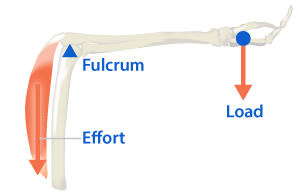
Class 2 - The fulcrum is at one end, the effort at the other end and the load lies between the effort and the fulcrum

Standing heel lift
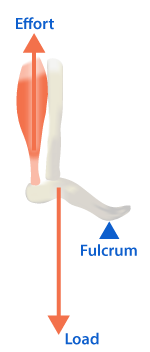
Class 3 - The fulcrum is at one end, the load at the other end and the effort lies between the load and the fulcrum

Seated biceps curl
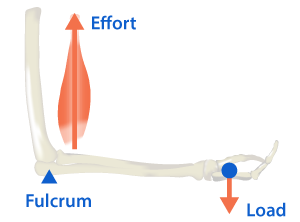
Steps of Problem Solving
Definition: Interviewing is face-to -face verbal encounters or exchange which is carefully planned, deliberately and skilfully executed and goal-oriented throughout.
Interview is more purposeful and organized than just conversation, but less formalised and standardised than a psychological test.
Behaviour is observable across:
*Obvious asymmetry, *abnormal speed, *accuracy, *whole body vs. localized movement
Interventions would then be undertaken to improve the sportspersons psychological state. E.g. relaxation techniques, mental rehearsal and positive self talk